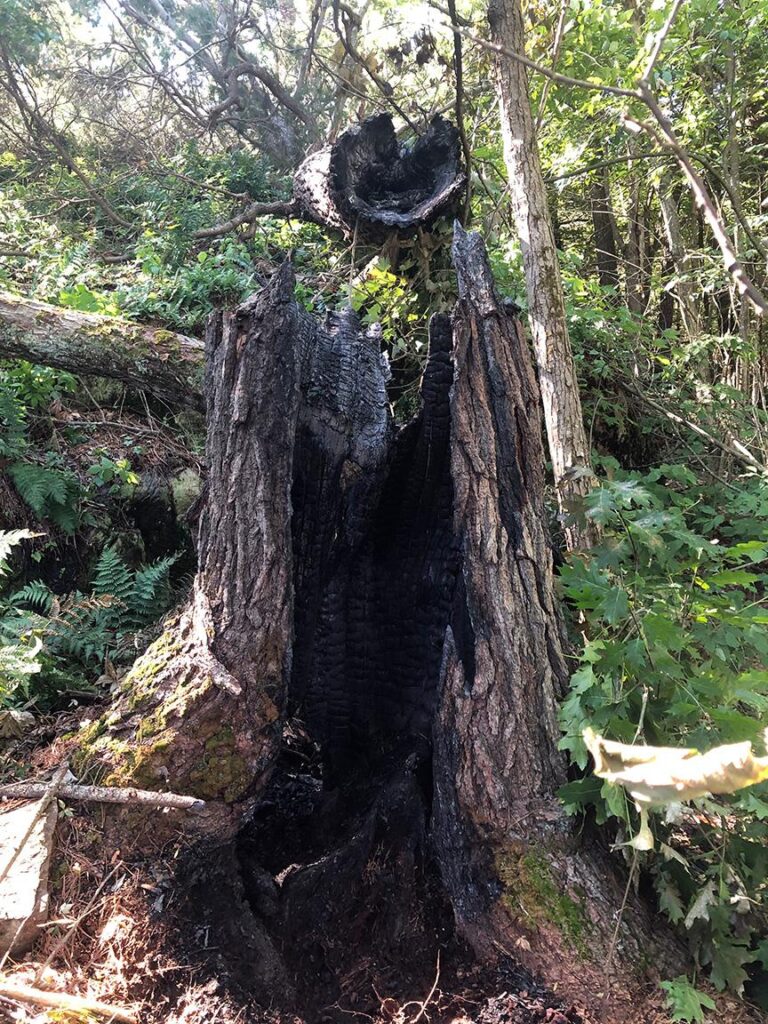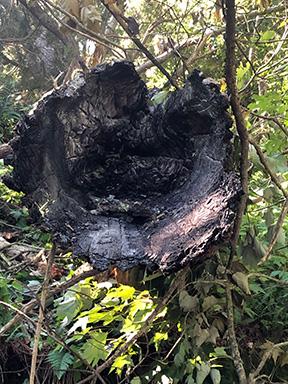
By David Sharpe
The smell of smoke as the wind shifted to the north was the first thing to raise my concern. My initial thought was that maybe someone was camping somewhere behind our cottage here on the Eastern shore of Shawanaga Inlet, and had lit a cooking fire.
Alone at the cottage on that morning, I took the dog in a kayak, and we paddled around to our back bay where a river empties out through a wetland.
Smoke was curling up through the high pines as I made my way along the shore.
Approaching the area through the marsh, I could see flames and smoke at ground level close to the shore. The closer I got it became clear that a huge pine had been struck by lightning two nights earlier during a short but violent thunderstorm. Felled by the blast and cleaved in two lengthwise, this ancient pine had been smouldering and now was fiercely ablaze.
Adrenaline fueled my rapid paddle back to the cottage. After frantically
- pulling on work boots and
- grabbing a fully-charged extinguisher and
- my cell phone,
the dog and I fought our way through the thick bush toward the smoke. Unloading the full charge of the fire extinguisher into the burning stump and split hollow trunk, it was soon clear to me that we needed a lot more suppression to get this spreading fire under control.
Then began the many hours of transport, set up, and running of our Honda fire pump utilizing 300 feet of hose through the bush. More hose arrived after my wife had returned to the cottage and arranged with a neighbour to bring the extra 40 feet needed to get right on top of the fire as it spread.
Even once the fire was out on the surface, I then shoveled down in the duff, exposed burning coals and smouldering peat. More digging and soaking continued until every hot spot was doused.
Several return visits to the site over the next 48 hours verified the threat was truly extinguished. (editor’s note – it is worth noting that fire can travel underground through the roots of one tree to another over a period of a year or two. it happened on Pawis Island in and around 2000)
Here are a few lessons I learned from this close brush with losing our cottage and the beautiful surrounding forest:
1. Be better prepared than I was with verified emergency contacts and local assistance. Emergency calls can be frustrating and chew up critical time. (My 911 calls were transferred to fire reporting stations which in turn transferred to regional stations that never picked up after repeated efforts) Our local contractor admonished me after the fact that he would have dropped everything and come with his crew to assist. Also, our Shawanaga First Nation neighbours have expertise and equipment ready to mobilize quickly.
2. Having a fire pump
- all gassed up,
- pre-tested and ready to start, and
- nozzles hoses stored close at hand, saved our property.
3. Having the hoses
- “zigzag folded” and
- laid flat in a portable storage bin, was a lifesaver. We could move them, along with the pump, to the shoreline close to the fire and quickly run them through the bush without the hose snagging and twisting as it was deployed. This twisting often results from hoses stored in rolls and hurriedly deployed.
4. After a close thunderstorm,
- do a god check for lightning ignition all around your area. I was away from the cottage the stormy night of July 11. My wife, alone that night, said a lightning flash, and the almost instantaneous thunderclap, almost knocked her out of bed, being so close and loud. Undoubtedly that was the strike that destroyed the old pine and began the fire.
5. Know who you’d contact in the case of a fire
- Consider those who have both the experience and fire suppression equipment
- Check out the Fire Pump listings in the 2022 Yearbook on pages 123-129 for those who have fire pumps – do they live nearby?
- Find your 2018 Yearbook & update the back flap that is the emergency card or take the time NOW to fill it in. Perhaps now is the time to be sure it’s updated with those who are willing and able to help in an emergency. Who would you call?
6. Reread emergency information that PaBIA provided several years ago: here is a PDF found on PaBIA’s website.
All’s well that ends well, but that was just a little too close for comfort. At the risk of stating the obvious, fire is that one threat that we, who live in an isolated community without immediately available emergency fire services, need to be vigilant about preventing. Being reminded can’t be a bad thing.

\